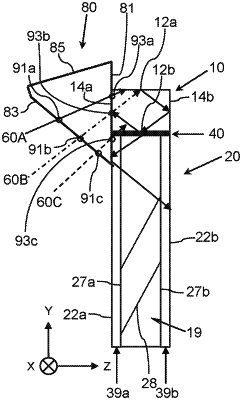| CPC G02B 6/0028 (2013.01) [G02B 6/0055 (2013.01)] | 7 Claims |

|
1. An optical aperture multiplier comprising:
a first optical waveguide having a first pair of parallel faces including a first face and a second face, and a second pair of parallel faces including a third face and a fourth face, the pairs of parallel faces together forming a rectangular cross-section, wherein a partially reflective surface is associated with, and is parallel to, the second face;
an optical coupling-in configuration for coupling polarized light corresponding to an image into the first optical waveguide with an initial direction of propagation at a coupling angle oblique to both the first and second pairs of parallel faces, the polarized light being s-polarized with regard to the second face; and
a second optical waveguide having a plurality of faces including a third pair of parallel faces, an optical coupling of the second optical waveguide with the first optical waveguide being such that that the second optical waveguide is optically coupled with the first optical waveguide at an interface between the second face and one of the faces of the second optical waveguide, wherein an optical coupling-out configuration is associated with the second optical waveguide,
wherein the partially reflective surface and the optical coupling of the second optical waveguide with the first optical waveguide are configured such that, when the light corresponding to the image is coupled into the first optical waveguide, the light advances by four-fold internal reflection along the first optical waveguide, with a proportion of intensity of the light transmitted at the partially reflective surface so as to be coupled into the second optical waveguide, and propagates within the second optical waveguide by internal reflection at the third pair of parallel faces, with a proportion of intensity of the light propagating within the second optical waveguide deflected out of the second optical waveguide by the optical coupling-out configuration.
|